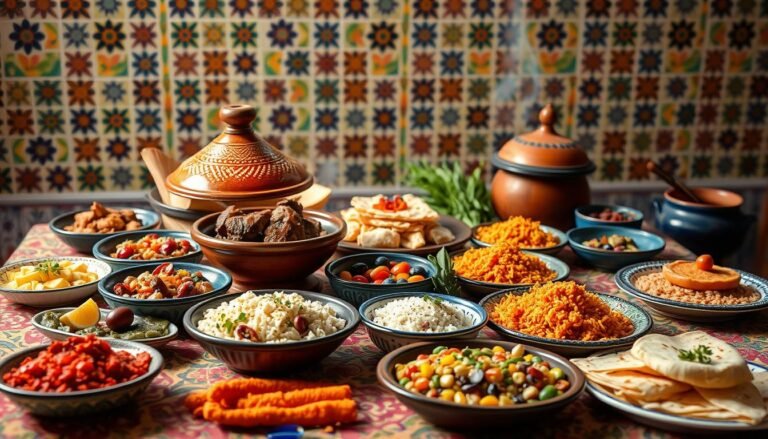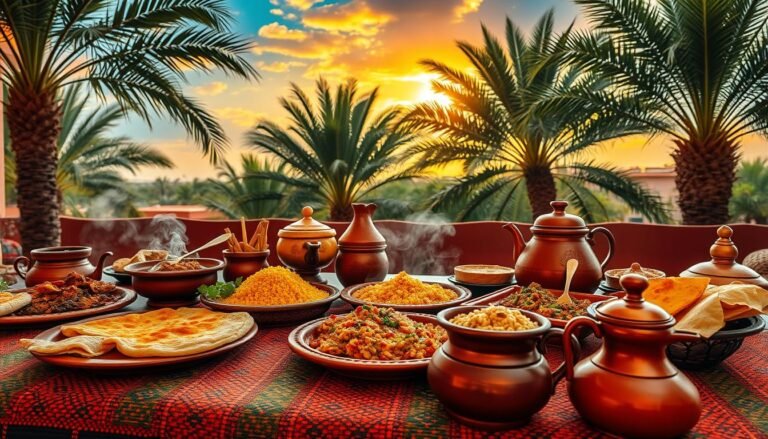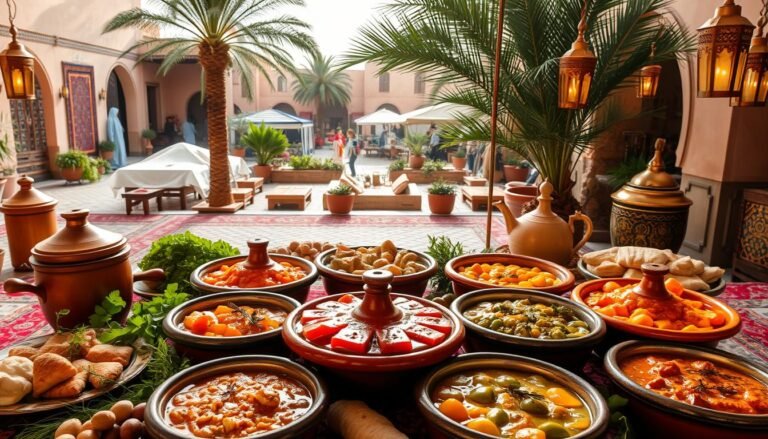Traditional Moroccan Food: Delicious Culinary Delights
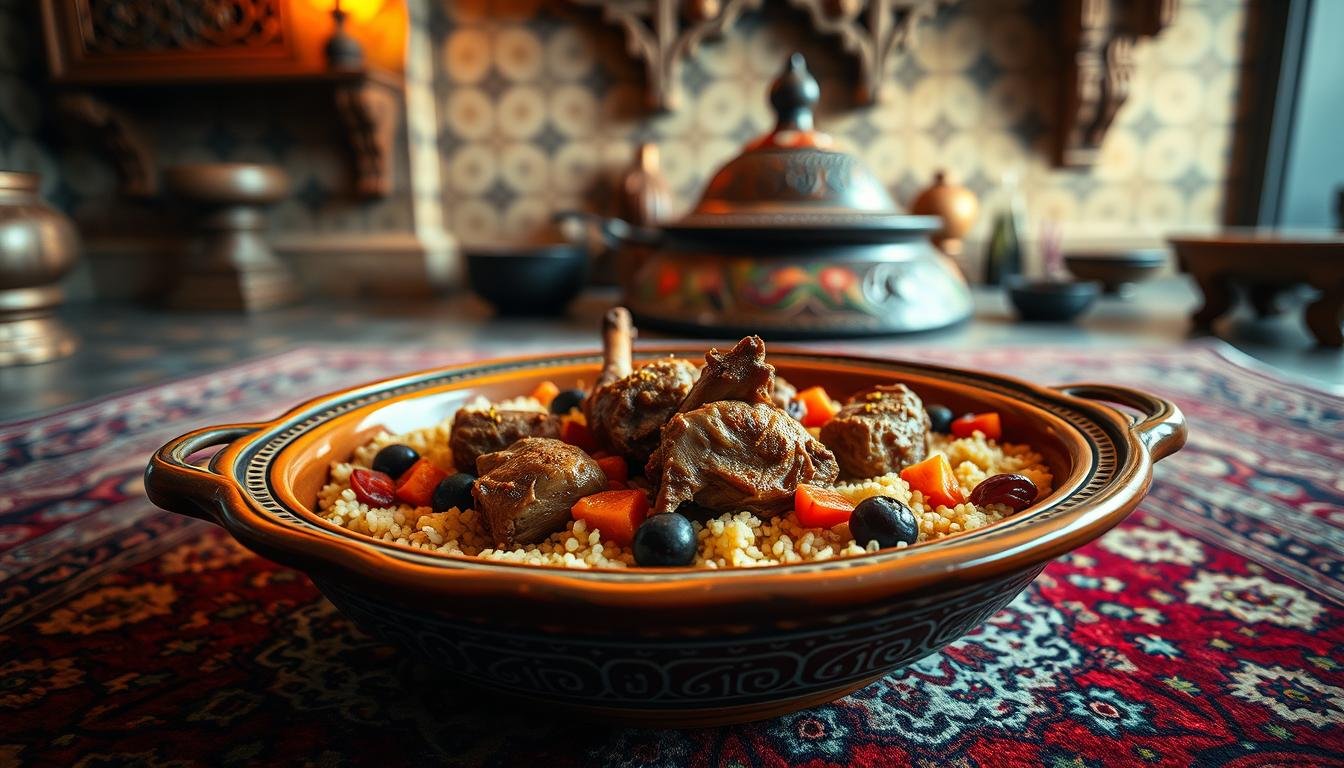
Imagine a cuisine where every bite tells a story, where flavors transport you across continents and centuries. Welcome to the vibrant world of Moroccan cooking, a culinary tapestry woven with threads from Andalusian Spain, Arabia, and France. This is a place where spices like cumin, saffron, and coriander dance together, creating dishes that are as aromatic as they are flavorful.
At the heart of this culinary journey are iconic dishes like tagine and couscous. Tagine, slow-cooked in a conical clay pot, allows steam to circulate, infusing every ingredient with deep, rich flavors. Couscous, often served on Fridays, is a comforting tradition that brings families together. These dishes are more than meals; they are experiences that connect us to a culture of hospitality and warmth.
Key Takeaways
- Moroccan cuisine blends spices and flavors from various cultures, creating a unique culinary identity.
- Tagine and couscous are cornerstone dishes, each with its own traditional cooking method.
- The use of spices like cumin, saffron, and coriander adds depth and complexity to Moroccan meals.
- Family and hospitality are central to Moroccan food traditions, with meals often served communally.
Introduction to the Rich World of Moroccan Cuisine
Step into the vibrant world of Moroccan cuisine, where flavors from across the globe come together in a delightful harmony. This cuisine is a fascinating blend of history and culture, shaped by influences from Andalusian Spain, Arabia, and France. Each dish tells a story of its rich heritage, creating a culinary experience like no other.
A Brief History and Influences
Moroccan cuisine has been shaped by centuries of cultural exchange. The blend of spices from Arabia, the sophistication of Andalusian Spain, and the elegance of French culinary techniques have crafted a unique flavor profile. This diversity is what makes Moroccan dishes so distinctive and flavorful.
Key Spices and Ingredients in Our Dishes
At the heart of Moroccan cooking are ingredients like tomatoes and garlic, which add a burst of flavor to every dish. Cumin, a cornerstone spice, is used generously to create depth and warmth. Other essential spices include coriander, cinnamon, and paprika, each contributing to the aromatic profile of Moroccan meals.
Moroccan cuisine is a celebration of color and aroma, offering a sensory experience that captivates the palate. With its rich history and vibrant ingredients, it’s no wonder this cuisine has won the hearts of food enthusiasts worldwide.
Exploring “traditional moroccan food” Treasures
Moroccan cuisine is a treasure trove of flavors, offering a wide array of dishes that delight the senses. From the slow-cooked tagines to the fluffy couscous, every dish tells a story of rich cultural heritage.
Diverse Dishes from Tagines to Couscous
Tagines and couscous are staples of Moroccan cuisine. These dishes are not just meals; they are experiences that highlight the country’s culinary expertise. Chicken and lamb are commonly used meats, each bringing unique flavors to the table.
Signature Flavors and Unique Cooking Techniques
The slow-cooking method and marination techniques used in Moroccan cooking bring out the best in the meat. Spices like cumin, coriander, and cinnamon add depth to the dishes, making them aromatic and flavorful. The traditional processes used in Moroccan kitchens ensure authenticity and preserve the cultural heritage of the cuisine.
Chicken and lamb are central to many Moroccan recipes, often slow-cooked to perfection. These dishes are more than just meals; they are a celebration of culture and tradition.
Delighting in Authentic Tagine Creations
Tagine, a cornerstone of Moroccan cuisine, offers a rich culinary journey through its diverse variations. Each dish is a testament to the art of slow cooking, where every ingredient is infused with deep, aromatic flavors. Whether it’s chicken, lamb, beef, or even pigeon, tagine creations captivate the senses with their complexity and warmth.
Chicken, Lamb, and Beef Variations
Chicken tagine, with its tender meat and zesty preserved lemons, is a delightful twist on traditional recipes. Lamb tagine, slow-cooked to perfection, offers a hearty, comforting experience. Beef tagine, with its robust flavor profile, is a favorite among meat lovers. For the adventurous, pigeon tagine provides a unique and exotic touch, often seasoned with aromatic cinnamon and spices.
The Art of Cooking in a Traditional Clay Pot
Cooking in a traditional clay pot is an art form. The tagine’s conical lid allows steam to circulate, ensuring even cooking and tender results. This method enhances the natural flavors of the ingredients, creating a dish that is both nourishing and flavorful.
| Tagine Variation | Key Ingredients | Characteristic Profile |
|---|---|---|
| Chicken Tagine | Chicken, preserved lemons, green olives | Bright, citrusy, slightly tangy |
| Lamb Tagine | Lamb, garlic, cinnamon | Rich, hearty, aromatic |
| Beef Tagine | Beef, tomatoes, onions | Robust, savory, slightly sweet |
| Pigeon Tagine | Pigeon, almonds, spices | Exotic, nutty, complex |
“The art of tagine cooking lies not just in the ingredients, but in the patience and love with which it’s prepared. Each dish tells a story of tradition and heritage.”
Cooking a tagine is more than just a meal; it’s an experience that connects us to the heart of Moroccan culture. With its blend of spices like cinnamon, cumin, and coriander, every tagine dish is a celebration of flavor and tradition.
Hearty Soups and Stews: Harira and Beyond
Imagine the warmth of a comforting bowl that captures the essence of Moroccan hospitality. This is where hearty soups and stews take center stage, with Harira being the crown jewel.
Fragrant Harira with Tomatoes, Lentils, and Chickpeas
Harira is more than just a soup; it’s a cherished tradition, especially during Ramadan. This flavorful dish is a perfect blend of tomatoes, lentils, and chickpeas, all slow-cooked in a rich broth. A squeeze of lemon juice adds a refreshing touch, making each sip a delight.
The Comforting Nature of Soups and Stews
These dishes are crafted to warm the heart and soul. The slow-cooked process ensures that every ingredient melds together, creating a deep, satisfying flavor. Whether it’s a light soup or a hearty stew, each bowl is a testament to the comfort of home-cooked meals.
Cultural Significance of Harira
Harira holds a special place in Moroccan culture, often served during Ramadan to break the fast. It’s a symbol of community and togetherness, bringing people around the table to share in the warmth of the meal.
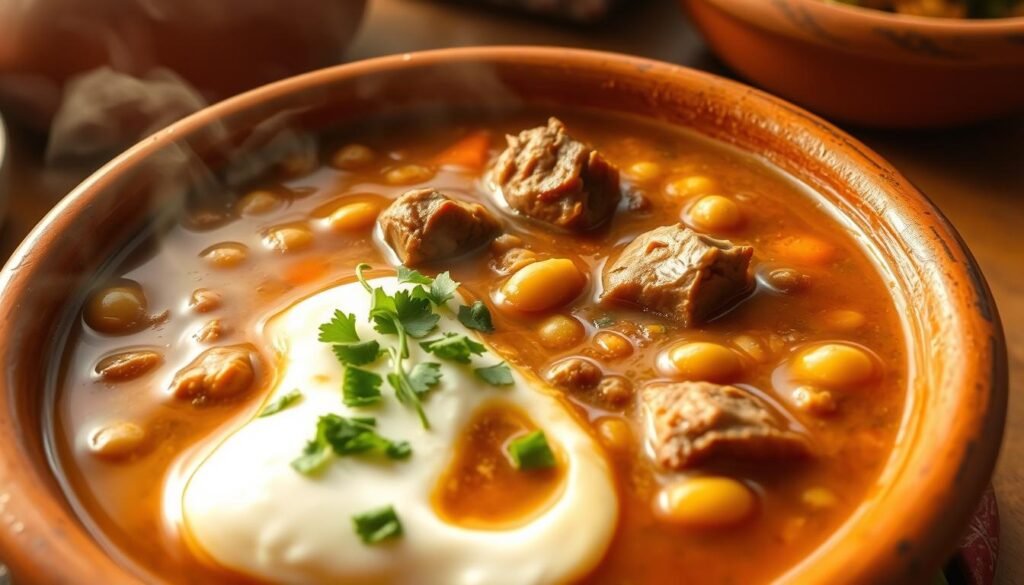
“Harira is more than soup; it’s a tradition that brings us together and nourishes both body and soul.”
With its robust broth, vibrant ingredients, and cultural significance, Harira and other soups and stews are a delicious reflection of Moroccan culinary heritage. Each bowl tells a story of warmth, comfort, and community.
Vibrant Salads and Savory Dips
Salads and dips are the perfect way to start a Moroccan meal. They bring freshness and color to the table, setting the tone for a delicious dining experience. These dishes are not just appetizers; they are a celebration of flavors and textures that prepare your palate for the feast ahead.
Zaalouk: The Smoked Aubergine Dip
Zaalouk is a beloved dip that showcases the richness of Moroccan flavors. Made with smoked aubergines, it’s a delightful blend of textures and tastes. The recipe begins with roasting eggplants to bring out their natural sweetness, then blending them with tomatoes, garlic, and a generous sprinkle of coriander.
The preparation of Zaalouk is an art. The eggplants are carefully smoked to enhance their flavor, while the tomatoes add a touch of acidity. Garlic and coriander are essential, providing depth and aroma. The result is a dip that’s both creamy and tangy, perfect for dipping bread or serving as a side.
Fresh herbs like coriander play a crucial role in Zaalouk, adding a bright, citrusy note. The hint of garlic balances the sweetness of the eggplants, creating a harmonious flavor profile. This dip is a testament to the vibrancy of Moroccan starters, offering a delightful contrast of colors and tastes.
Zaalouk is more than just a dip; it’s an experience. With its rich flavors and aromatic spices, it invites you to explore the diverse world of Moroccan cuisine. Each bite tells a story of tradition and the art of blending simple ingredients into something extraordinary.
Classic Couscous and Steamed Delicacies
Couscous, a fine wheat pasta with Berber origins, is a cornerstone of Moroccan cuisine. This beloved dish, often served with meat and vegetables, holds a special place as Morocco’s national dish. Its preparation is steeped in tradition, reflecting the country’s rich cultural heritage.
The traditional method involves hand-rolling semolina into small spheres, a labor-intensive process that enhances the pasta’s texture. The steaming process, using a couscoussier, allows steam to circulate, ensuring the pasta is light and fluffy. This technique, passed down through generations, is integral to achieving the dish’s signature texture and flavor.
The art of combining vegetables and meats in couscous creates a balanced and nutritious meal. Vegetables like carrots, zucchini, and turnips are carefully selected for their color and texture, while meats such as chicken or lamb add depth. The result is a harmonious blend of flavors and nutrients.
For an authentic couscous recipe, start by toasting pine nuts and sautéing onions and garlic. Add spices like cumin, coriander, and cinnamon, then incorporate your choice of protein. Steam the couscous over the simmering broth, occasionally fluffing it with a fork. Serve with a medley of steamed vegetables and a drizzle of olive oil.
| Ingredients | Quantity |
|---|---|
| Couscous | 1 cup |
| Vegetable broth | 2 cups |
| Carrots | 1 cup, chopped |
| Zucchini | 1 cup, sliced |
| Chicken or lamb | 1 pound, cut into pieces |
| Cumin | ¼ teaspoon |
| Coriander | ¼ teaspoon |
| Cinnamon | ¼ teaspoon |
| Garlic | 2 cloves, minced |
| Olive oil | 1 tablespoon |
Couscous is more than a meal; it’s a cultural symbol. Often served at gatherings and special occasions, it embodies Moroccan hospitality and togetherness. This dish, with its comforting warmth and rich flavors, continues to be a cherished part of the country’s culinary identity.

Street Food Marvels: Makouda and Local Snacks
Step into the lively streets of Morocco, where every corner offers a culinary adventure. Street food here is more than just a quick bite; it’s a celebration of flavors and culture.
Exploring the Bustle of Moroccan Markets
Visit any bustling market, and you’ll be greeted by the irresistible aromas of street delicacies. Makouda, crispy deep-fried potato balls, is a favorite snack. These golden treats are often served with a side of spicy harissa sauce, adding a bold kick to each bite.
Another highlight is chermoula-marinated fish, grilled to perfection over coals. The combination of fresh herbs, garlic, and spices creates a flavor profile that’s both tangy and aromatic. Paired with a drizzle of olive oil, this dish is a must-try for any street food enthusiast.
Tantalizing Flavors from Deep-Fried Potato Balls and More
Makouda’s appeal lies in its simplicity and crunch. These potato balls are typically served with a dollop of creamy sauce or a sprinkle of fresh herbs. The contrast of textures and flavors makes them irresistible to locals and visitors alike.
Fish dishes are equally popular, with options like marinated sardines and mackerel. Cooked over open flames, these dishes are often served with a slice of fresh bread, perfect for dipping into the flavorful sauce. The combination of smoky fish and tangy sauce is a true delight.
Street food in Morocco is a testament to the country’s rich culinary heritage. From the bustling markets to the aromatic dishes, every bite tells a story of tradition and innovation. Whether you’re savoring makouda or enjoying grilled fish, the experience is nothing short of extraordinary.
Sweet and Savory Pastries: The Art of B’stilla
B’stilla is a masterpiece of Moroccan pastry-making, blending the finest ingredients into a dish that is both a feast for the eyes and the palate. This delicate pastry, often referred to as the “savory pie,” showcases the artistry of Fassi cuisine, making it a standout dish in the country.
Layered Perfection with Pigeon Meat, Almonds, and Spices
B’stilla is renowned for its intricate layering process, which creates a harmonious balance of flavors and textures. The dish typically features pigeon meat, though modern variations often use chicken, layered with toasted almonds, saffron-infused eggs, and a blend of aromatic spices like cinnamon and ginger. This layering technique ensures that each bite is a perfect mix of savory and sweet elements.
| Ingredients | Quantity |
|---|---|
| Warqa dough | 12 sheets |
| Pigeon meat | 1 pound |
| Almonds | 1/2 cup, toasted |
| Saffron threads | 1 teaspoon |
| Eggs | 4 large |
| Cinnamon | 1 teaspoon |
| Ginger | 1 teaspoon |
The preparation of B’stilla is an art form. The warqa dough, thin and delicate, is layered to create a flaky crust. The filling, a rich mixture of pigeon meat, almonds, and spices, is carefully placed in the center. The dish is then baked to perfection, resulting in a golden, aromatic pastry that is both visually stunning and delicious.
Culturally, B’stilla holds a special place in Moroccan cuisine. It is often served at special occasions and celebrations, symbolizing luxury and refinement. The combination of sweet and savory flavors, along with the meticulous preparation process, makes B’stilla a true delicacy.
B’stilla is more than just a dish; it’s a cultural symbol. Its intricate layers and balanced flavors make it a must-try for anyone exploring Moroccan cuisine. Whether served at a grand celebration or a intimate gathering, B’stilla is sure to impress with its unique blend of tradition and flavor.
Refreshing Mint Tea Rituals
In the heart of Moroccan hospitality lies a refreshing ritual that brings people together and warms the soul. Mint tea, often referred to as “Moroccan whisky,” is more than just a drink; it’s a symbol of respect and friendship. Brewed with gunpowder tea, fresh mint leaves, and plenty of sugar, this beverage is a cornerstone of social gatherings in Morocco.
Brewing the Perfect Cup of Moroccan Mint Tea
The preparation of mint tea is an art form. It begins with boiling water and green tea leaves, followed by the addition of fresh mint and sugar. The first brew is often discarded to remove bitterness, ensuring a smooth and sweet flavor in the final cup. The process involves multiple infusions, each carefully timed to achieve the perfect balance of flavors.
Cultural Significance and The Crown of Froth
Serving tea in Morocco is a gesture of hospitality and respect. The ritual includes creating a frothy “crown” when pouring the tea, which is considered a mark of skill. This crown adds a delightful texture to the drink, enhancing the overall experience. The tea is typically served in small glasses, and the host pours the tea from a height to create the desired foam.
The cultural significance of mint tea extends beyond the drink itself. It is a symbol of community and togetherness, often served during social gatherings and celebrations. The process of brewing and serving tea is a cherished tradition that reflects the values of Moroccan hospitality.
Conclusion
As we conclude our journey through the vibrant world of Moroccan cuisine, we reflect on its rich cultural heritage and the bold flavors that define it. This cuisine is a harmonious blend of Berber, Arab, and European influences, creating a unique culinary identity that captivates the senses.
From the slow-cooked tagines to the fragrant couscous, every dish tells a story of tradition and hospitality. The liberal use of spices like cumin, coriander, and cinnamon adds depth and warmth, making each meal a memorable experience. Whether it’s the hearty tagines or the delicate pastries, Moroccan cuisine offers a diverse array of flavors that cater to every palate.
We encourage you to try these authentic recipes at home, starting with a simple chicken tagine or a hearty couscous dish. The slow-cooking method and careful balance of spices will transport your taste buds to the bustling markets of Morocco. Remember, the key to a great Moroccan meal lies in the patience and love with which it’s prepared.
As you explore this culinary treasure trove, let the aromatic spices and rich ingredients guide you. Whether you’re preparing a festive b’stilla or a comforting bowl of harira, every dish is a celebration of Morocco’s rich heritage. So, take a moment to appreciate the artistry and tradition behind each recipe, and let the vibrant flavors of this incredible cuisine inspire your next culinary adventure.

